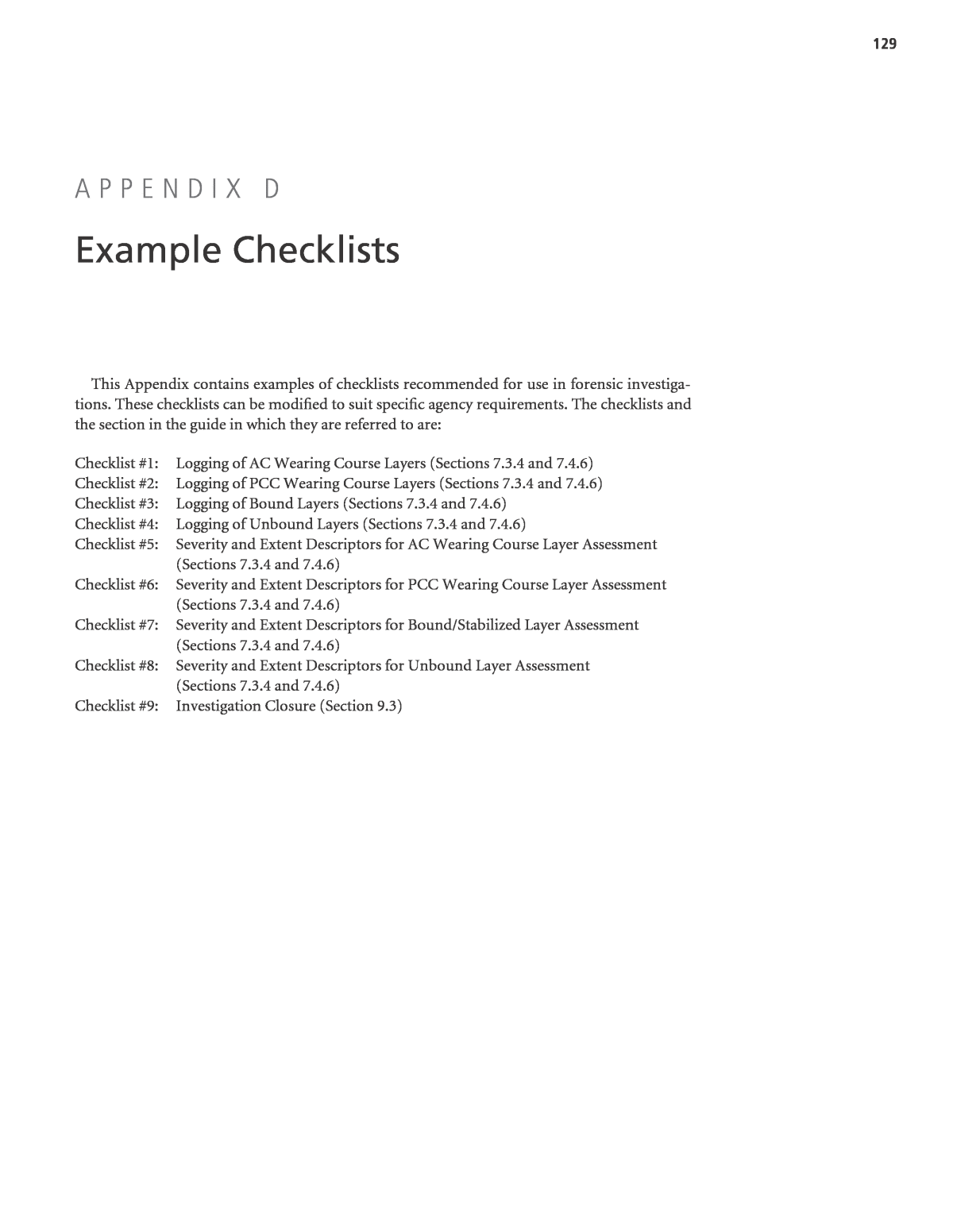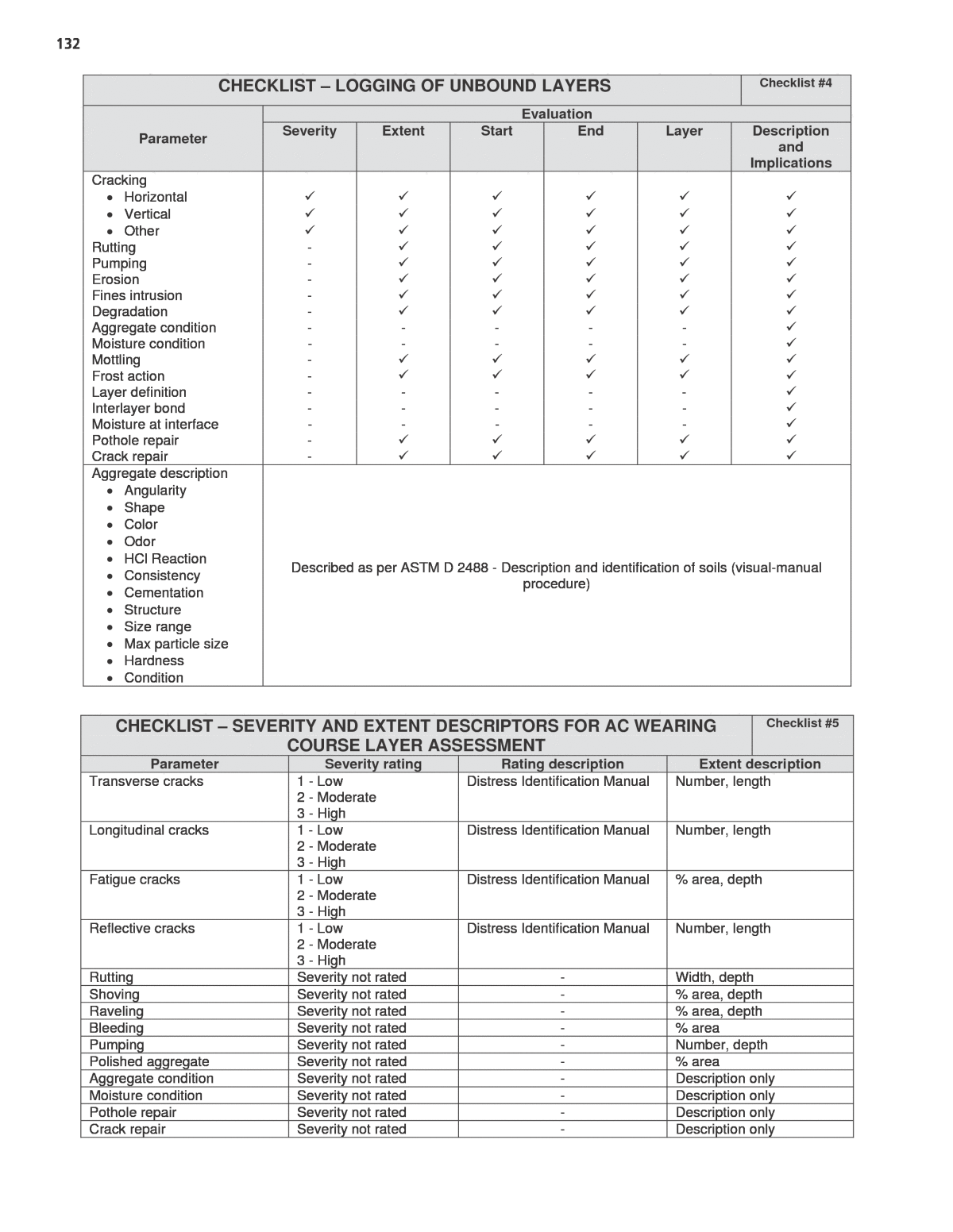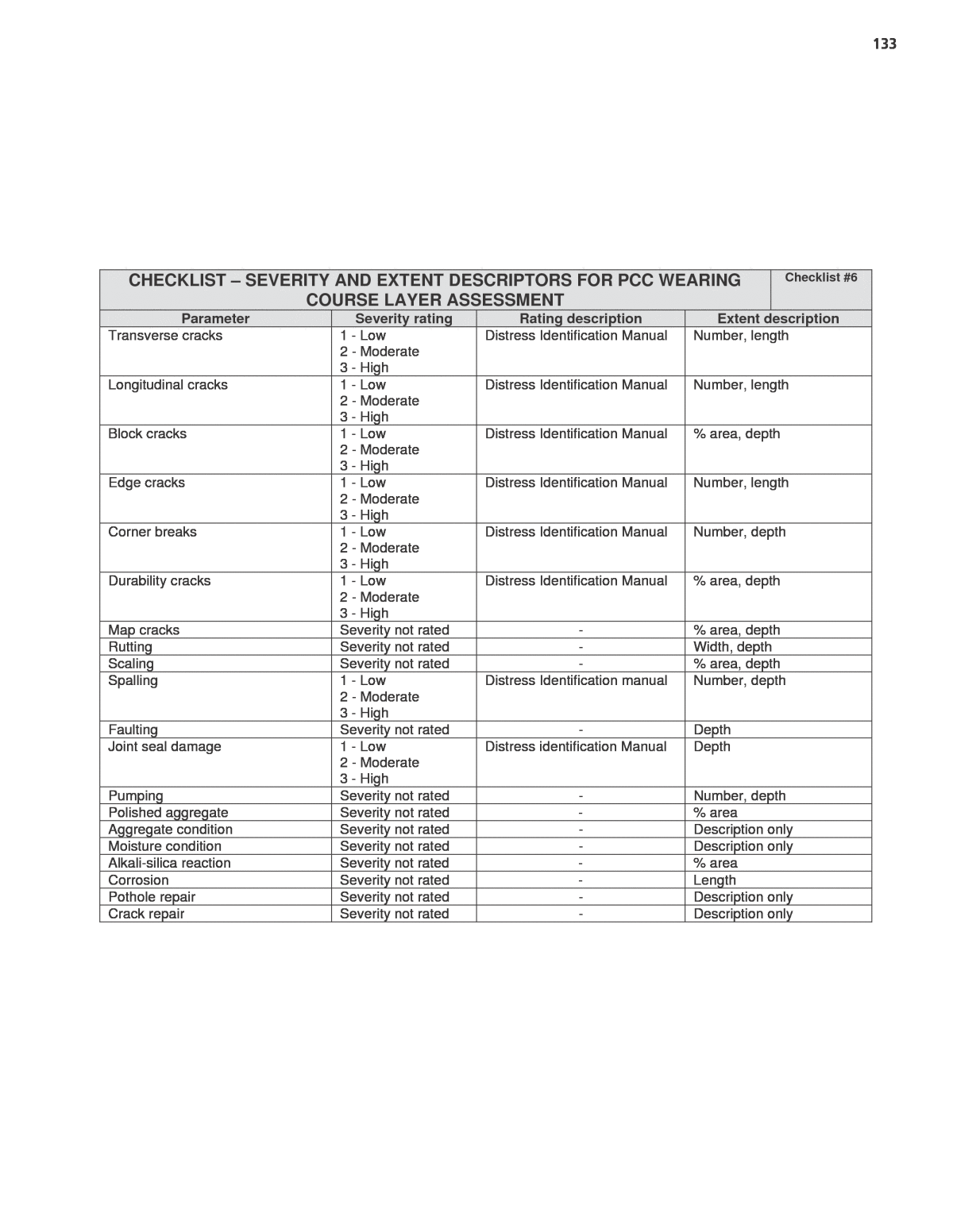






Below is the uncorrected machine-read text of this chapter, intended to provide our own search engines and external engines with highly rich, chapter-representative searchable text of each book. Because it is UNCORRECTED material, please consider the following text as a useful but insufficient proxy for the authoritative book pages.
129 This Appendix contains examples of checklists recommended for use in forensic investiga- tions. These checklists can be modified to suit specific agency requirements. The checklists and the section in the guide in which they are referred to are: Checklist #1: Logging of AC Wearing Course Layers (Sections 7.3.4 and 7.4.6) Checklist #2: Logging of PCC Wearing Course Layers (Sections 7.3.4 and 7.4.6) Checklist #3: Logging of Bound Layers (Sections 7.3.4 and 7.4.6) Checklist #4: Logging of Unbound Layers (Sections 7.3.4 and 7.4.6) Checklist #5: Severity and Extent Descriptors for AC Wearing Course Layer Assessment (Sections 7.3.4 and 7.4.6) Checklist #6: Severity and Extent Descriptors for PCC Wearing Course Layer Assessment (Sections 7.3.4 and 7.4.6) Checklist #7: Severity and Extent Descriptors for Bound/Stabilized Layer Assessment (Sections 7.3.4 and 7.4.6) Checklist #8: Severity and Extent Descriptors for Unbound Layer Assessment (Sections 7.3.4 and 7.4.6) Checklist #9: Investigation Closure (Section 9.3) A p p e n d i x d Example Checklists
130 CHECKLIST â LOGGING OF AC WEARING COURSE LAYERS Checklist #1 Parameter Evaluation Severity Extent Start End Layer Description and implications Cracking Transverse Longitudinal Fatigue Reflective Rutting - Shoving - Raveling - - - - Bleeding - Pumping - Polished aggregate - - - - Aggregate condition - - - - - Moisture condition - - - - - Pothole repair - Crack repair - CHECKLIST â LOGGING OF PCC WEARING COURSE LAYERS Checklist #2 Parameter Evaluation Severity Extent Start End Layer Description and implications Cracking Transverse Longitudinal Block Edge Corner Durability Map - Rutting (chain wear) - Scaling - - - - Spalling - - - Faulting - - - - Joint seal damage - - - Pumping - Polished aggregate - - - - Aggregate condition - - - - - Moisture condition - - - - - Alkali-silica reaction - - Corrosion - - - - Pothole repair - Crack repair -
131 CHECKLIST â LOGGING OF BOUND LAYERS Checklist #3 Parameter Evaluation Severity Extent Start End Layer Description and Implications Cracking Horizontal Vertical Other Rutting - Pumping - Erosion - Fines intrusion - Degradation - Aggregate condition - - - - - Moisture condition - - - - - Mottling - Frost action - Layer definition - - - - - Interlayer bond - - - - - Moisture at interface - - - - - Pothole repair - Crack repair - Bleeding1 - Carbonation2 - Aggregate description Angularity Shape Color Odor HCl Reaction Consistency Cementation Structure Size range Max particle size Hardness Condition Described as per ASTM D 2488 - Description and identification of soils (visual-manual procedure) 1 Asphalt-treated base only 2 Cement treated base only
132 CHECKLIST â LOGGING OF UNBOUND LAYERS Checklist #4 Parameter Evaluation Severity Extent Start End Layer Description and Implications Cracking Horizontal Vertical Other Rutting - Pumping - Erosion - Fines intrusion - Degradation - Aggregate condition - - - - - Moisture condition - - - - - Mottling - Frost action - Layer definition - - - - - Interlayer bond - - - - - Moisture at interface - - - - - Pothole repair - Crack repair - Aggregate description Angularity Shape Color Odor HCl Reaction Consistency Cementation Structure Size range Max particle size Hardness Condition Described as per ASTM D 2488 - Description and identification of soils (visual-manual procedure) CHECKLIST â SEVERITY AND EXTENT DESCRIPTORS FOR AC WEARING COURSE LAYER ASSESSMENT Checklist #5 Parameter Severity rating Rating description Extent description Transverse cracks 1 - Low 2 - Moderate 3 - High Distress Identification Manual Number, length Longitudinal cracks 1 - Low 2 - Moderate 3 - High Distress Identification Manual Number, length Fatigue cracks 1 - Low 2 - Moderate 3 - High Distress Identification Manual % area, depth Reflective cracks 1 - Low 2 - Moderate 3 - High Distress Identification Manual Number, length Rutting Severity not rated - Width, depth Shoving Severity not rated - % area, depth Raveling Severity not rated - % area, depth Bleeding Severity not rated - % area Pumping Severity not rated - Number, depth Polished aggregate Severity not rated - % area Aggregate condition Severity not rated - Description only Moisture condition Severity not rated - Description only Pothole repair Severity not rated - Description only Crack repair Severity not rated - Description only
133 CHECKLIST â SEVERITY AND EXTENT DESCRIPTORS FOR PCC WEARING COURSE LAYER ASSESSMENT Checklist #6 Parameter Severity rating Rating description Extent description Transverse cracks 1 - Low 2 - Moderate 3 - High Distress Identification Manual Number, length Longitudinal cracks 1 - Low 2 - Moderate 3 - High Distress Identification Manual Number, length Block cracks 1 - Low 2 - Moderate 3 - High Distress Identification Manual % area, depth Edge cracks 1 - Low 2 - Moderate 3 - High Distress Identification Manual Number, length Corner breaks 1 - Low 2 - Moderate 3 - High Distress Identification Manual Number, depth Durability cracks 1 - Low 2 - Moderate 3 - High Distress Identification Manual % area, depth Map cracks Severity not rated - % area, depth Rutting Severity not rated - Width, depth Scaling Severity not rated - % area, depth Spalling 1 - Low 2 - Moderate 3 - High Distress Identification manual Number, depth Faulting Severity not rated - Depth Joint seal damage 1 - Low 2 - Moderate 3 - High Distress identification Manual Depth Pumping Severity not rated - Number, depth Polished aggregate Severity not rated - % area Aggregate condition Severity not rated - Description only Moisture condition Severity not rated - Description only Alkali-silica reaction Severity not rated - % area Corrosion Severity not rated - Length Pothole repair Severity not rated - Description only Crack repair Severity not rated - Description only
134 CHECKLIST â SEVERITY AND EXTENT DESCRIPTORS FOR BOUND/STABILIZED LAYER ASSESSMENT Checklist #7 Parameter Severity rating Rating description Extent description Horizontal cracks 1 - Low 2 - Moderate 3 â High 0.25 in. (5 mm) 0.25 â 0.75 in. (5 - 20 mm) > 0.75 in. (20 mm) Number, length Vertical cracks 1 - Low 2 - Moderate 3 â High 0.25 in. (5 mm) 0.25 â 0.75 in. (5 - 20 mm) > 0.75 in. (20 mm) Number, length Other cracks 1 - Low 2 - Moderate 3 â High 0.25 in. (5 mm) 0.25 â 0.75 in. (5 - 20 mm) > 0.75 in. (20 mm) Number, length Rutting Severity not rated - Width, depth Pumping Severity not rated - Number, depth Erosion Severity not rated - % area Fines intrusion Severity not rated - % area, depth Degradation Severity not rated - % area Aggregate condition Severity not rated - Description only Moisture condition Severity not rated - Description only Mottling Severity not rated - % area Frost action Severity not rated - Depth Layer definition Severity not rated - Description only Interlayer bond Severity not rated - Description only Moisture at interface Severity not rated - Description only Pothole repair Severity not rated - Description only Crack repair Severity not rated - Description only Bleeding Severity not rated - % area Carbonation Severity not rated - % area, depth CHECKLIST â SEVERITY AND EXTENT DESCRIPTORS FOR UNBOUND LAYER ASSESSMENT Checklist #8 Parameter Severity rating Rating description Extent description Horizontal cracks 1 - Low 2 - Moderate 3 - High 0.25 in. (5 mm) 0.25 â 0.75 in. (5 - 20 mm) > 0.75 in. (20 mm) Number, length Vertical cracks 1 - Low 2 - Moderate 3 - High 0.25 in. (5 mm) 0.25 â 0.75 in. (5 - 20 mm) > 0.75 in. (20 mm) Number, length Other cracks 1 - Low 2 - Moderate 3 - High 0.25 in. (5 mm) 0.25 â 0.75 in. (5 - 20 mm) > 0.75 in. (20 mm) Number, length Rutting Severity not rated - Width, depth Pumping Severity not rated - Number, depth Erosion Severity not rated - % area Fines intrusion Severity not rated - % area, depth Degradation Severity not rated - % area Aggregate condition Severity not rated - Description only Moisture condition Severity not rated - Description only Mottling Severity not rated - % area Frost action Severity not rated - Depth Layer definition Severity not rated - Description only Interlayer bond Severity not rated - Description only Moisture at interface Severity not rated - Description only Pothole repair Severity not rated - Description only Crack repair Severity not rated - Description only Bleeding Severity not rated - % area
135 CHECKLIST â INVESTIGATION CLOSURE Checklist #9 General Issues Yes No Comments 1 Has the investigation been completed in terms of the requirements of the experiment work plan? 2 Have the objectives of the investigation been met? 3 Is termination of the investigation justified? 4 Have all reports as required in the investigation work plan been written? 5 Have all reports had an independent technical review? 6 Have all reports been logged and numbered in the central register? 7 Have the required steps been taken to have the findings implemented? 8 Have the findings been presented to relevant departments and if applicable, published? 9 Has all data been captured in the database and backed up? 10 Have the cost spreadsheet and project file been closed and archived? 11 Have materials samples been disposed of? 12 Have signs, markings, and instrumentation been removed from site? 13 Have all team members and other interested and affected parties been notified? 14 15 Recommendation Was the investigation successfully completed? Yes No If no, state why and what needs to be done to complete it Name: Signature: Date:
